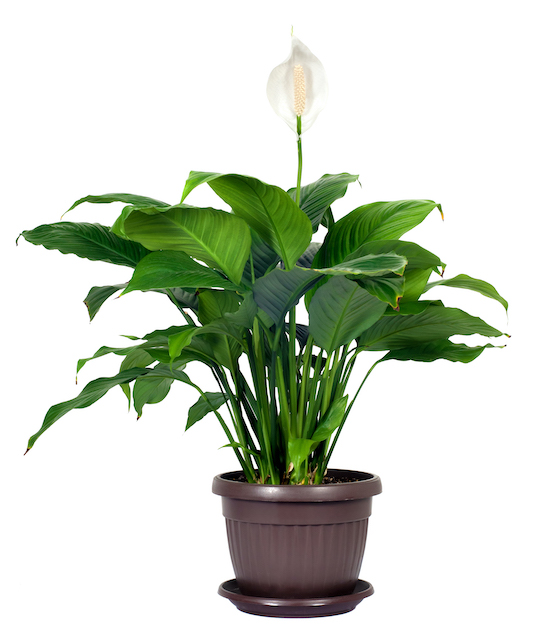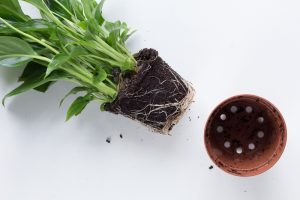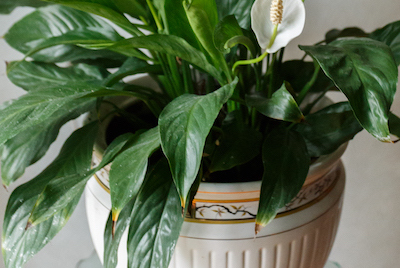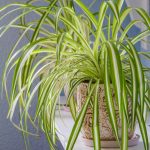The peace lily plant is a favourite of indoor gardeners! The beautiful, glossy, dark green leaves are excellent air purifiers and create a show of superb foliage. With clumping, bushy growth the peace lily will reach about 16″ (40cm) to 18″ (45cm) in height and width. Bright, white flowers provide a striking contrast against the dark foliage and it’s a lovely plant to bring the outdoors inside.

 |
 |
 |
 |
| Light | Water | Ease of Growing | Growth Rate |
| Grows best in bright, indirect light but will tolerate low light. Avoid direct sunlight. | Keep the potting mix moist, but be careful not to overwater. Avoid allowing it to sit in water. | Very easy, great for beginners. | Moderately fast given the right conditions. |
A number of varieties are available offering size variations and leaf color variations. The ‘petite’ and S. wallisii are smaller varieties growing to between 8″ (20cm) – 12″ (30cm), whereas the ‘sensation’ can grow 4′ (1.2m) – 6′ (1.8m) tall. For leaf color variation try the ‘domini’, a variegated peace lily plant or the ‘mojo lime’ which has a lime-green foliage.
To encourage flowering, peace lilies do require bright light (but not direct sun). Flowers can be expected, usually 2 – 3 at a time, from early summer and may continue during the year if given optimal conditions. Some indoor gardeners suggest that allowing the plant to become slightly root bound can help to promote flowering.
Peace Lily Plant Care Guide
Light
The most important thing with a peace lily is to avoid direct sunlight as the leaves can easily get damaged. For optimal growth bright, indirect light is best, however it can adjust to lower light levels. The growth will be slower though and it probably won’t flower.
Wiping the leaves down with a soft, damp cloth to remove any dust helps the leaves utilize the available light for photosynthesis and promotes healthy plant growth.
Water
A peace lily plant does require regular watering to keep the potting mix moist. It’s important to allow the water to soak through and drain away so the plant is not sitting in water.
Before watering lift the pot to feel its weight and poke your finger in the soil. Only give it a drink if the top inch feels dry. Peace lilies will let you know when they need a drink as their leaves become quite droopy, but don’t wait for this sign. In winter, they won’t require as much water.
They can tolerate short periods of dry soil every now and then, but not on a regular basis. Water the soil around the base of the plant and not the leaves and if you can, rainwater or filtered water is best.
Individual plants will all have varying water requirements depending on how many leaves they have, the size of their pot and how much light they receive as this will affect how much they photosynthesise. Generally plants with lush growth will require more regular watering.
Temperature
Being from the tropics, your peace lily plant will prefer a warm place in your home. They don’t like cold drafts from windows, doors or aircon vents. Temperatures need to be above 55 degrees Fahrenheit (13 degrees Celsius).
Humidity
If you have very low humidity you may have some problems with your peace lily. This can be improved by misting your plant regularly or sitting them on a pebble tray, which is also great for catching excess water.
Fertilizer
Peace lily plants will benefit from a regular feed, about once a month during the growing season. Use a half-strength liquid fertilizer, starting in late winter to prepare the plant for spring growth.
Pruning
To keep your peace lily looking lovely, prune off flower spikes once they have finished and remove any dead or yellowing leaves. As the leaves get older it is normal for the odd leaf to turn yellow. This is not of concern unless many leaves are turning yellow at the same time.
Peace Lily Planting Guide
Soil
For best results use a general potting mix that is free draining. Peace lily plants will benefit from being repotted every year in spring with fresh soil. If they are in a very large pot, the top soil can be removed and fresh soil added on top.

Repotting
When it’s time to repot your peace lily, use a pot with about an 8″ (20cm) diameter. The roots may be growing together and around the edge of the pot so tease these out and any particularly circular roots can be removed.
Propagation
If your plant has filled up it’s pot, it may be time to divide the peace lily clump. Separate it into 2 sections, with an even amount of leaves on each one and then replant them separately. Your plants may take a couple of weeks to recover. Ensure to water them well and ensure they have plenty of bright, filtered light.

Growing in Water
Yes! Peace lily plants can be grown directly in water. Ensure the plant is propped up by pebbles so that the roots can grow into the water, not the stem or it may rot.
Common Problems With A Peace Lily Plant
If you see small, brown discs on the underside of peace lily leaves and stems, this could be the presence of scale. It needs to be removed with a soft, damp cloth and then the plant treated with pest oil spray.
Mealybugs can also infect peace lilies. They look like small patches of fluffy, white cotton and can be found on the stems and undersides of the leaves. If you do see any, deal with them quickly by wiping them off with a damp cloth and soapy water and then treating with insecticide. It may require repeated treatment to prevent a more serious infestation.
Browning leaf tips can be a problem for peace lily plants and may occur if the soil dries out too much, too often or if the humidity is too low. Sometimes overwatering can cause brown, soft patches on leaf edges. Too much direct sunlight or too much fertilizer can also cause browning of the leaves. Yellowing leaves could be caused by underwatering or simply old age.

Toxicity
Peace lilies do contain calcium oxalate and are mildly poisonous. They can cause stomach upset and irritation of the mouth and lips if ingested. Be careful with cats as they are particularly attracted to the flower spikes.
Summary of Peace Lily Plant Care
Do:
- water regularly to keep soil moist
- provide bright light for optimal growth
- wipe down the leaves to remove dust
- mist the leaves
Don’t:
- leave it sitting in water
- expect flowers from a plant in low light
- let it dry out repeatedly
- ignore drooping leaves
Interesting Facts
- Peace lily ‘Mauna Loa’ has been rated by NASA as one of the top air purifying plants.
- The name ‘peace lily’ comes from the white flower spike that is reminiscent of a white flag raised in surrender.
This is one of our most highly recommended fast growing house plants. Ideal for both the beginner and the experienced indoor gardener. If you are looking for a statement plant, the lush, green foliage will add beauty and style to your home. Easy to care for, the peace lily plant is definitely one to add to your collection.






